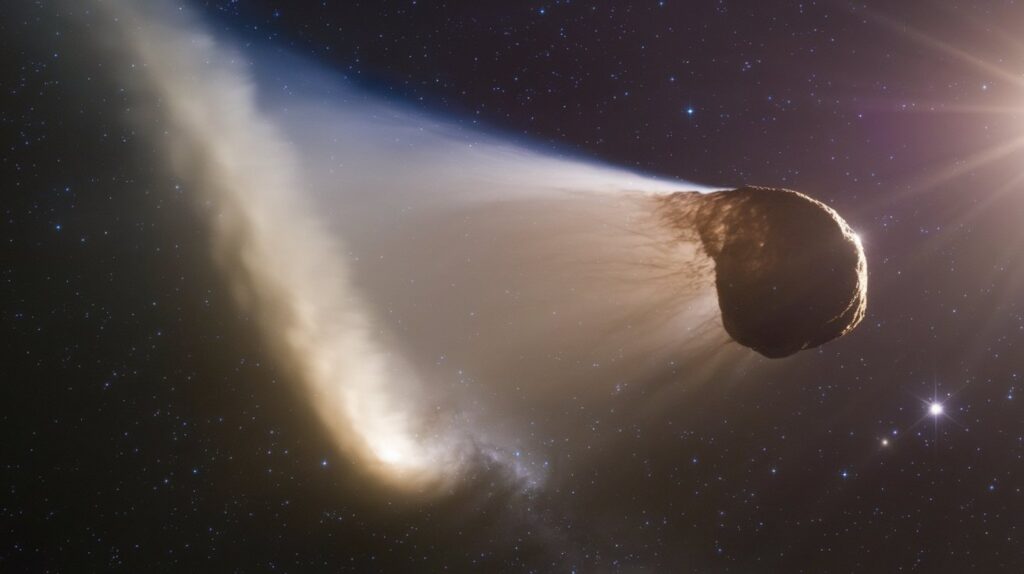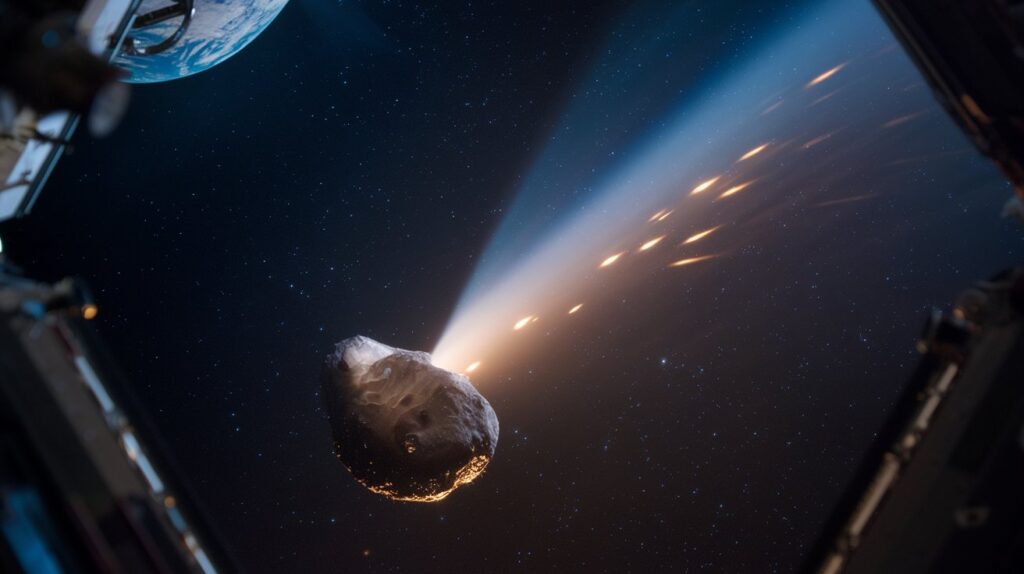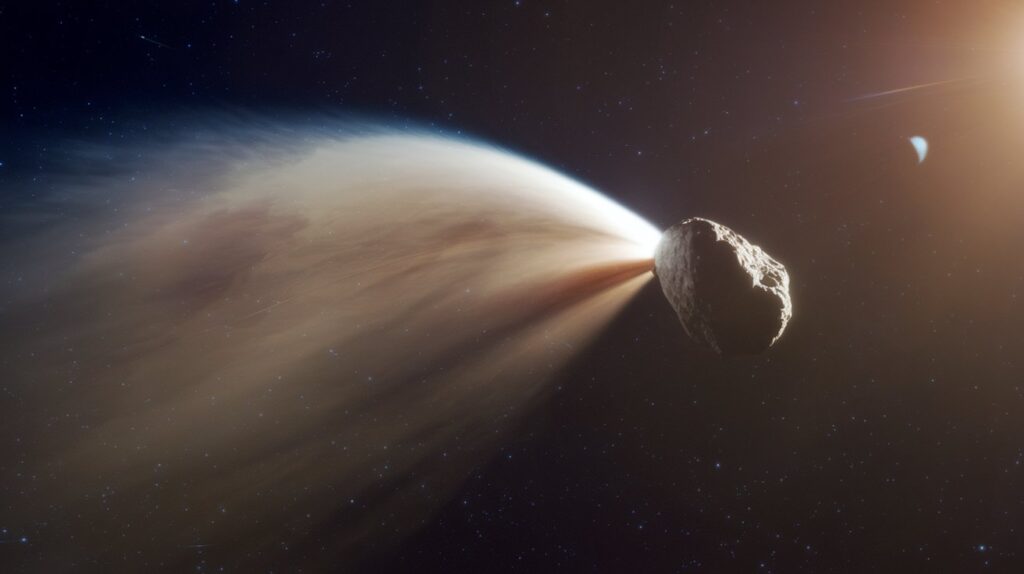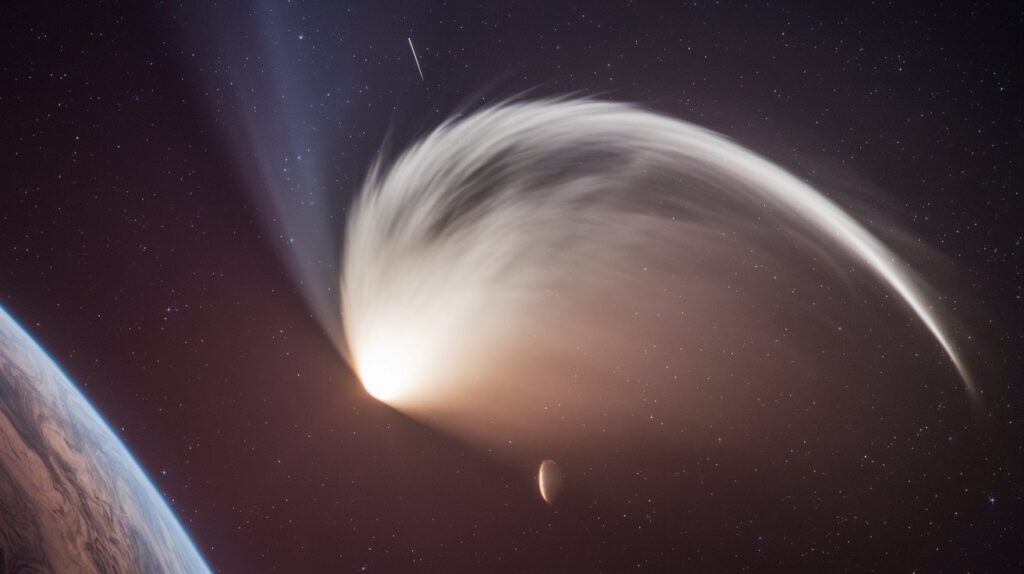
Comets are some of the most fascinating objects in the night sky. These icy celestial bodies have long intrigued humans with their brilliant tails and mysterious journeys across the cosmos. In this blog, we’ll explore what a comet is, how it behaves, and why it has such an iconic tail made of gas and dust. Our user-friendly guide will walk through the basics of comets, their structure, and their significance. We’ll also answer some frequently asked questions (FAQ) to make sure you leave with a well-rounded understanding of these giant ice balls that orbit the Sun.
What is a Comet?
At its core, a comet is a large ball of ice and rock that orbits the Sun in a highly eccentric orbit. These celestial objects can vary greatly in size but are usually a few miles across. Comets originate from regions of the solar system far from the Sun, such as the Kuiper Belt and Oort Cloud, where icy bodies exist in a frozen state.
- Shape and Orbit: Unlike planets, which have nearly circular orbits, comets follow highly elliptical paths. This means that at certain points in their orbit, they come very close to the Sun, while at others, they travel far into the outer solar system.
- Core (Nucleus): The solid center of the comet, known as the nucleus, is primarily made up of rock, dust, water ice, and frozen gases such as carbon dioxide, methane, and ammonia.
- Gas and Dust: As the comet approaches the Sun, the heat causes the ice and gases to vaporize, forming a glowing cloud around the nucleus called a coma. Dust and gases are released, and these create the tail that makes a comet stand out in the night sky.
A comet is a small celestial body made of ice, dust, and rocky material that orbits the Sun. Unlike planets, comets have highly elliptical orbits, meaning they can come close to the Sun and then travel far into the outer reaches of the solar system. When a comet approaches the Sun, the heat causes its icy core to vaporize, creating a glowing atmosphere around it called a coma. This coma, along with the pressure from solar radiation and the solar wind, forms a long, glowing tail that always points away from the Sun.
Comets are often described as “dirty snowballs” because of their mixture of ice and dust. They originate from two main regions of the solar system:
- Kuiper Belt: A region beyond Neptune that is home to many short-period comets, which have orbits of less than 200 years.
- Oort Cloud: A distant, spherical shell surrounding the solar system, containing long-period comets with orbits that can take thousands of years to complete.
Famous comets include Halley’s Comet, which is visible from Earth approximately every 76 years, and Comet Hale-Bopp, which was widely observed in 1997.

Basic Characteristics of a Comet
| Component | Description |
|---|---|
| Nucleus | Solid center made of rock, dust, water ice, and frozen gases |
| Coma | Glowing cloud of vaporized gases surrounding the nucleus |
| Dust Tail | Long trail of dust particles pushed by sunlight |
| Gas Tail | Ionized gases blown by solar winds forming a separate tail |
| Orbit | Highly elliptical, often taking the comet far from and close to the Sun |
The Origin of Comets
Comets are believed to come from two primary regions of the solar system: the Kuiper Belt and the Oort Cloud. These regions are filled with icy bodies that were left over from the formation of the solar system about 4.6 billion years ago.
The Kuiper Belt
The Kuiper Belt is a region beyond the orbit of Neptune that is home to many small, icy bodies. Objects from this area are known as short-period comets, which means they take less than 200 years to complete an orbit around the Sun. Some well-known comets, such as Comet Halley, likely originated from the Kuiper Belt.
The Oort Cloud
The Oort Cloud is a much more distant region of the solar system and is thought to be a spherical shell surrounding the entire solar system. Comets from the Oort Cloud are called long-period comets because their orbits can take thousands of years. These comets can be unpredictable since their orbits are influenced by the gravity of passing stars and even the galactic tide.
Comets are thought to have originated from the early stages of the solar system’s formation, around 4.6 billion years ago. They are remnants from the protoplanetary disk, a rotating disk of gas, dust, and ice that surrounded the young Sun. While much of this material formed planets, moons, and asteroids, some of it was left over and ended up in the outermost regions of the solar system, where it formed comets.
The two primary regions where comets are believed to originate are:

1. Kuiper Belt
- Located beyond Neptune, the Kuiper Belt is a disk-shaped region extending from about 30 to 55 astronomical units (AU) from the Sun (1 AU is the average distance between the Earth and the Sun).
- It is home to short-period comets, which take less than 200 years to complete an orbit around the Sun. These comets have relatively stable orbits and return to the inner solar system frequently.
- Objects in the Kuiper Belt are composed mostly of ice, and when some of them are disturbed by gravitational interactions, they can be pushed inward, becoming visible as comets.
2. Oort Cloud
- The Oort Cloud is a hypothetical, spherical shell of icy bodies that lies much farther away from the Sun, from about 2,000 to 100,000 AU.
- It is the source of long-period comets, which take thousands to millions of years to orbit the Sun. These comets can come from any direction in the sky because of the spherical distribution of the Oort Cloud.
- The Oort Cloud is thought to have formed as icy planetesimals (small, early solar system objects) were ejected into distant orbits by the gravitational influence of the giant planets like Jupiter and Saturn.
Formation and Evolution of Comets
During the early solar system, the outer regions, where temperatures were lower, allowed volatile compounds such as water, methane, ammonia, and carbon dioxide to freeze. Comets formed in these cold environments, with a mixture of these ices and rock. The gravitational interactions with the gas giants (Jupiter, Saturn, Uranus, and Neptune) flung many of these objects outward, into the Kuiper Belt and Oort Cloud, where they remained for billions of years.
Occasionally, gravitational disturbances—caused by passing stars, other celestial bodies, or even within the solar system—disrupt these comets’ orbits, sending them hurtling toward the inner solar system. As they approach the Sun, the solar radiation heats their icy surface, producing the characteristic coma and tail.
Comets thus offer valuable insights into the early conditions of the solar system, as they are made of the primordial material that has remained relatively unchanged for billions of years.

Why Do Comets Have Tails?
Comets have tails because of the effects of the Sun’s heat and solar wind on the comet’s nucleus when it approaches the inner solar system. The process of tail formation can be understood in the following steps:
1. Comet’s Structure:
A comet consists of a nucleus made up of ice, dust, and rocky material. When it is far from the Sun, the nucleus remains frozen, and the comet is relatively inactive.
2. Sublimation and Formation of Coma:
As the comet moves closer to the Sun, the increasing heat causes the ices in the nucleus to sublimate—that is, turn directly from solid to gas. This process releases gases and dust, which form a glowing atmosphere around the nucleus called the coma. The coma can be thousands of kilometers wide and is what makes the comet visible to observers on Earth.
3. Tails Form Due to Solar Radiation and Solar Wind:
Once the coma forms, the Sun’s radiation and the solar wind (a stream of charged particles from the Sun) interact with the gas and dust, creating two distinct tails:
a. Ion Tail (Gas Tail):
- The ion tail is made of ionized gases, such as carbon dioxide, carbon monoxide, and water vapor, that have been stripped of electrons by ultraviolet light from the Sun.
- The solar wind pushes these ionized particles away from the comet, forming a straight, narrow tail that always points directly away from the Sun, regardless of the comet’s direction of travel.
- This tail often has a bluish color due to the emission of light from ionized gases.
b. Dust Tail:
- The dust tail is made of small, solid particles that are ejected from the nucleus along with the gases. These particles are much larger than gas molecules, so they are less affected by the solar wind and radiation.
- Instead of pointing straight away from the Sun, the dust tail curves slightly and follows the comet’s orbit, forming a broad, diffuse tail.
- The dust tail appears whitish or yellowish because it reflects sunlight.
4. Tail Size and Shape:
The tails of comets can grow extremely long, often stretching millions of kilometers across space. The ion tail tends to be more linear and narrow, while the dust tail is broader and more curved. The formation and orientation of the tails are determined by the interplay between the Sun’s radiation, solar wind, and the comet’s motion.
In Summary:
- Ion tail (gas tail): Always points directly away from the Sun, due to solar wind, and is often blue.
- Dust tail: Curves slightly in the direction of the comet’s orbit, reflecting sunlight and appearing yellowish or white.
These tails give comets their iconic appearance and are most prominent when the comet is closest to the Sun in its orbit, a phase known as perihelion.
One of the most iconic features of a comet is its bright, glowing tail. But where exactly does this tail come from?
As a comet gets closer to the Sun, the heat causes the ice on the surface of the nucleus to vaporize. This process, called sublimation, occurs when the solid ice turns directly into a gas, skipping the liquid phase. As the ice vaporizes, it releases dust and gas, which are pushed away from the comet by solar radiation and the solar wind. This creates the tail of the comet.
There are two types of tails:
- Dust Tail: This tail is made up of small dust particles that are pushed away from the comet by sunlight. The dust tail is often bright and curves gently.
- Gas (Ion) Tail: This tail is formed by gases that are ionized by the Sun’s rays and blown directly away by the solar wind. The gas tail is usually straight and points directly away from the Sun.
The Two Tails of a Comet
| Tail Type | Composition | Cause | Appearance |
|---|---|---|---|
| Dust Tail | Dust particles | Pushed by sunlight | Curved and bright |
| Gas Tail | Ionized gases | Blown by solar wind | Straight, points away from the Sun |
Famous Comets in History
Throughout history, comets have captivated humanity’s imagination and even sparked fear. Some of the most famous comets have made periodic visits to the inner solar system and have been observed for centuries.
Halley’s Comet
Perhaps the most famous comet, Halley’s Comet is a short-period comet that appears roughly every 76 years. Named after Edmond Halley, who first predicted its return, Halley’s Comet last passed by the Earth in 1986 and is expected to return in 2061. It has been visible since at least 240 BCE, making it one of the longest recorded comets in human history.
Comet Hale-Bopp
Comet Hale-Bopp was discovered in 1995 and became visible to the naked eye in 1997. It was one of the brightest comets of the 20th century, and its passage was observed worldwide for months. Hale-Bopp is a long-period comet, meaning it won’t be seen again for over 2,500 years.
The Scientific Importance of Comets
Comets provide scientists with a unique glimpse into the early solar system. Because they are largely unchanged since their formation, comets act as time capsules, holding clues about the material that existed when the solar system was still forming.
- Studying the Early Solar System: Comets contain ice and dust that are billions of years old. By studying this material, scientists can learn more about the early conditions of the solar system.
- Bringing Water to Earth: Some scientists believe that comets may have been responsible for bringing water to Earth. As comets collided with the planet during its formation, they could have delivered large amounts of water, contributing to the formation of oceans.
- Potential for Life: Comets also contain organic molecules, the building blocks of life. Studying these molecules can give us insight into how life might have started on Earth or elsewhere in the universe.
Scientific Discoveries from Comets
| Scientific Focus | Insight Gained |
|---|---|
| Solar System Formation | Comets hold primitive material from the solar system’s early days |
| Water on Earth | Comets may have delivered water, contributing to Earth’s oceans |
| Organic Molecules | Comets contain organic molecules, which are the building blocks of life |
Fun Facts About Comets
Here are some fascinating facts about comets that might surprise you:
- Fact 1: A comet’s tail always points away from the Sun, no matter which direction the comet is traveling.
- Fact 2: The word “comet” comes from the Greek word “kometes,” which means “long-haired,” referring to the tail.
- Fact 3: Some comets are so bright that they can be seen during the day. The Great Comet of 1680 was visible even in broad daylight.
Key Takeaways
- Comets are icy bodies that orbit the Sun in highly elliptical orbits.
- As a comet approaches the Sun, its ice and dust vaporize, forming a glowing tail of gas and dust.
- There are two types of comet tails: the dust tail and the gas (ion) tail.
- Comets come from distant regions like the Kuiper Belt and Oort Cloud.
- Scientists study comets to learn about the early solar system and the potential origins of water and life on Earth.
Important Point
| NO. | Important Points |
| 1. | About Us |
| 2. | Contact Us |
| 3. | Disclaimer |
| 4. | Privacy Policy |
FAQs of Comet
What is the difference between a comet and a meteor?
A comet is a large body made of ice, dust, and rock that orbits the Sun. A meteor is a piece of debris (often from a comet or asteroid) that burns up upon entering Earth’s atmosphere, creating a streak of light.
Do all comets have tails?
Not all comets have visible tails. A comet only develops a tail when it gets close to the Sun, as the heat causes the ice and dust to vaporize and form the distinctive tail.
How do scientists study comets?
Scientists use telescopes, space missions, and even landers to study comets. One of the most famous missions was the Rosetta mission, which successfully landed a probe on Comet 67P/Churyumov–Gerasimenko.
How often can we see comets from Earth?
The visibility of comets from Earth depends on their orbits. Some comets, like Halley’s Comet, appear once every 76 years, while others may only be visible once in thousands of years.
Can a comet hit Earth?
While it’s possible for a comet to collide with Earth, the chances are extremely low. Most comets have orbits that take them far from our planet.
